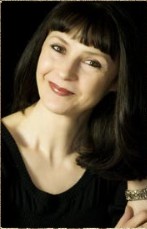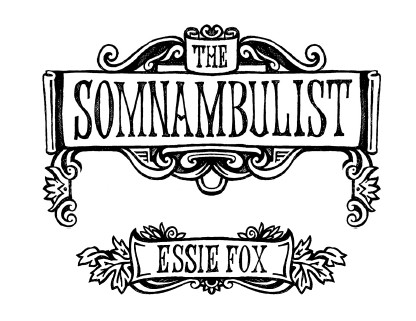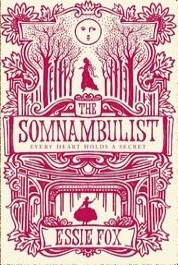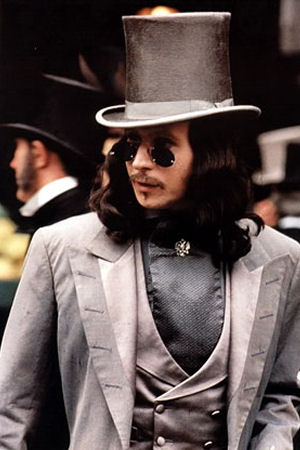Rispondi al commento
Passione e Mistero nella Londra Gotico - Vittoriana di Essie Fox

Scrittrice inglese al suo debutto letterario con "La Sonnambula" - uscito in Italia quest'anno, poco prima di Natale, grazie alla Castelvecchi Editore - di cui potrete leggere la recensione domani su questo stesso sito, Essie Fox ha un passato di editor ed illustratrice. Da qualche anno è riuscita a concretizzare il suo sogno nel cassetto, nonchè passione : scrivere. Oltre a ciò ha un blog molto interessante e famoso che tratta di tutto ciò che attiene l'epoca vittoriana di cui è un' appassionata cultrice, il cui nome è Virtual Victorian !
Se avete piacere di conoscere qualcosa in più su di lei e sulla sua prima, ma promettentissima opera vi lascio all'intervista che ci ha rilasciato!
Buona Lettura !

- Gent.ma Sig.ra Fox, grazie per essere per la prima volta sul nostro blog. Le andrebbe di presentarsi alle nostre lettrici e dirci com'è nata la sua passione per la scrittura?
Ciao - e grazie per avermi accolto nel vostro blog.
Io vivo a Londra e Windsor, e ho iniziato a scrivere solo da poco, dopo aver lavorato come illustratrice per 20 anni. Prima ancora ho lavorato per riviste e case editrici, è un mondo che ho sempre amato e al quale volevo tornare – e a cui torno solo ora come autore piuttosto che sul versante editoriale.
Dearest Mrs. Fox, thank you to be here for the first time, on our blog. Can you introduce yourself to our readers and tell us about your passion for writing?
Hello – and thank you for welcoming me to your blog. I live in London and Windsor, and I only started to write recently after working as an illustrator for 20 years. But, before that, I worked for magazine and book publishers, and that is a world I have always loved and to which I wanted to return – only now as an author rather than on the editorial side.
- Com’è nata l’idea con la storia narrata ne “La Sonnambula”?
La Sonnambula è stata ispirata da un quadro preraffaellita di Millais che si chiama Una Sonnambula, e da cui ho preso il nome per il mio romanzo. Si tratta di un dipinto che si dice essere basato su 'La donna in bianco’ di Wilkie Collins, ha una sensazione di mistero vittoriano che ha tutti gli elementi gotici che ho cercato di includere nel mio libro, insieme a un drammatico evento centrale, che include una giovane donna sonnambula nel cuore della notte. Il suo triste destino è ciò che è costruito intorno nel resto del romanzo.
How did you get the idea for "The Somnambulist"?
 The Somnambulist was inspired by a Pre-Raphaelite painting by Millais which is called A Somnambulist, and from which I have taken my novel’s name. It is a painting that is said to be based on Wilkie Collins’ The Woman in White, a Victorian sensation mystery that has all the gothic elements that I’ve now tried to include in my own book, along with a central dramatic event that includes a young woman sleepwalking in the dead of night. Her sad fate is what the rest of the novel is built around.
The Somnambulist was inspired by a Pre-Raphaelite painting by Millais which is called A Somnambulist, and from which I have taken my novel’s name. It is a painting that is said to be based on Wilkie Collins’ The Woman in White, a Victorian sensation mystery that has all the gothic elements that I’ve now tried to include in my own book, along with a central dramatic event that includes a young woman sleepwalking in the dead of night. Her sad fate is what the rest of the novel is built around.
- Le andrebbe di parlarci della protagonista del libro, Phoebe. A chi si è ispirata per crearla? C’è qualcosa di Lei in Phoebe?
La Phoebe delle prime righe del romanzo mi è venuta in mente completamente formata. Onestamente non so da dove la sua 'voce' sia venuta, ma non appena l’ho 'sentita', sapevo tutto di lei - come appariva, la sua età e dove viveva. La sua voce è quasi un sussurro entusiasta all'inizio, ma poi è molto giovane e ingenua e mentre cresce - più saggia - lo fa diventare (il respiro) più serio.
Would you like to tell us something about the book's heroine, Phoebe. Who did you get the inspiration for this character? Is there something of you in Phoebe?
Phoebe’s opening lines in the novel came into my mind fully formed. I honestly don’t know where her ‘voice’ came from, but as soon as I ‘heard’ it, I knew all about her – how she looked, her age, and where she lived. Her voice is quite breathless and enthusiastic at first, but then she is very young and naïve and as she grows older – and wiser – it does become more serious.
- Oltre alla protagonista (Phoebe) ed all’arte (con il quadro di Millais, La Sonnambula) - nel libro esiste un terzo essenziale protagonista, il Teatro. Esso è infatti fondamentale sia come ambientazione e sfondo del romanzo, sia per il ruolo che ricopre nella vita della protagonista e dei personaggi secondari del romanzo. Come ha scelto proprio il teatro come fulcro del romanzo?
Il Wilton Music Hall è un teatro vittoriano attualmente esistente che oggi è ancora aperto al pubblico. Sono andata a visitarlo di persona una notte per uno spettacolo con un’ operetta di Handel, ‘Aci e Galatea’ - e quando mi sono seduta tra il pubblico ho potuto quasi assaporare la storia che filtra attraverso le pareti fatiscenti e dalle scintillanti colonnine esterne di ottone che giravano intorno. Fu subito la mattina dopo che svegliandomi incominciai a 'sentire' la voce di Phoebe - e da lì tutta la storia ha cominciato a crescere. Anche Phoebe visita il Music Hall, ma nel suo periodo di massimo splendore vittoriano. Volevo che lei avesse familiari molto vicini a lei e amici che fossero coinvolti nel mondo del teatro - un mondo da cui lei è fortemente attirata, piena di glamour e colore e rumore e bang.Volevo che hanno legami familiari e amici che sono stati coinvolti nel mondo del teatro - un mondo da cui è fortemente attirati, piena di glamour e colore e rumore ed esplosione.
In addition to the main character (Phoebe) and the art (with the Millais’s panting, The Somnambulist) in the book there’s a third protagonist, the Theatre. It is important both as setting and background of the novel, both for the role it plays in Phoebe’s as well as the secondary characters' lives. How did you choose the theater as the fulcrum of the novel?
Wilton’s Music Hall is an actual Victorian theatre that is still open up to the public today. I went to visit myself one night for a performance of Handel’s operetta, Acis and Galatea – and when sitting in the audience I could almost taste the history seeping out through the crumbling walls, and glinting off the lovely brass pillars around. It was the very next morning that I woke up to ‘hear’ Phoebe’s voice – and from there the whole story began to grow. Phoebe also visits that music hall, but in its Victorian heyday. I wanted her to have close family connections and friends who were involved in the theatre world – a world to which she is strongly drawn, full of glamour and colour and clatter and bang.
- Cosa l’ha colpita così profondamente dell’opera “Aci e Galatea” tanto da inserirla nel libro quasi come un’ossessione per alcuni personaggi?
Tema centrale dell'opera è una sorta di triangolo amoroso - una storia di passione e amore non corrisposto che finisce in tragedia e una vendetta per gelosia. Sembrava la scelta perfetta - considerando ciò che accade ad alcuni personaggi del ‘La Sonnambula’ – per fare da eco alla storia dell'opera. Ho anche guidato il lettore con molti capitoli estratti dal libretto - quasi come se fosse ancora in grado di sentire la voce del cantante, o come se fosse un fantasma che lo perseguita, proprio come perseguita Phoebe. Infine è lì per piantare i semi nella mente del lettore come a suggerirgli ciò che potrebbe venire dopo.
What struck you so deeply in the opera "Acis and Galatea" to put it in the book, almost like an obsession for some characters?
The opera’s central theme is something of a love triangle – a story of passion and unrequited love that ends in tragedy and jealous revenge. It seemed the perfect choice – considering what happens to some characters in The Somnambulist – to echo the opera’s story. I have also headed up many chapters with excerpts from the libretto – almost as if the reader is still able to hear the singer’s voice, or as if it is a ghost that is haunting us, just as it is haunting Phoebe. And finally, it is there to plant seeds in the reader’s mind as to what might well be coming next.
- Come mai ha scelto un’ambientazione “gotica” ?
Ho sempre amato leggere i libri gotici - e dicono che si dovrebbe scrivere di ciò che si ama. Ho anche un ossessione per l'epoca vittoriana, e fondere questi due amori insieme sembrava la cosa più naturale.

Why did you choose a "Gothic" setting?
I’ve always loved reading gothic books – and they say you should write what you love. I also have an obsession with the Victorian era, and to blend those two loves together seemed the most natural thing.
- Quali sono i suoi prossimi progetti?
Al momento sto scrivendo un altro mistery gotico-vittoriano che sarà pubblicato in Inghilterra verso la fine del 2012. E’ la storia di un artista che è ossessionato dal dipingere la sua musa come una sirena ... ma non posso dire molto di più per ora!
What are your next projects?
I’m writing another Victorian gothic mystery at the moment which will be published in England towards the end of 2012. It is the story of an artist who is obsessed with painting his muse as a mermaid...but I can’t say much more for now!
Grazie mille per la disponibilità e la cortesia a Essie Fox
Thanks so much for the kindness and courtesy to Essie Fox














Commenti recenti
7 anni 20 settimane fa
7 anni 20 settimane fa
7 anni 20 settimane fa
7 anni 20 settimane fa
7 anni 20 settimane fa
7 anni 21 settimane fa
7 anni 21 settimane fa
7 anni 21 settimane fa
7 anni 21 settimane fa
7 anni 21 settimane fa